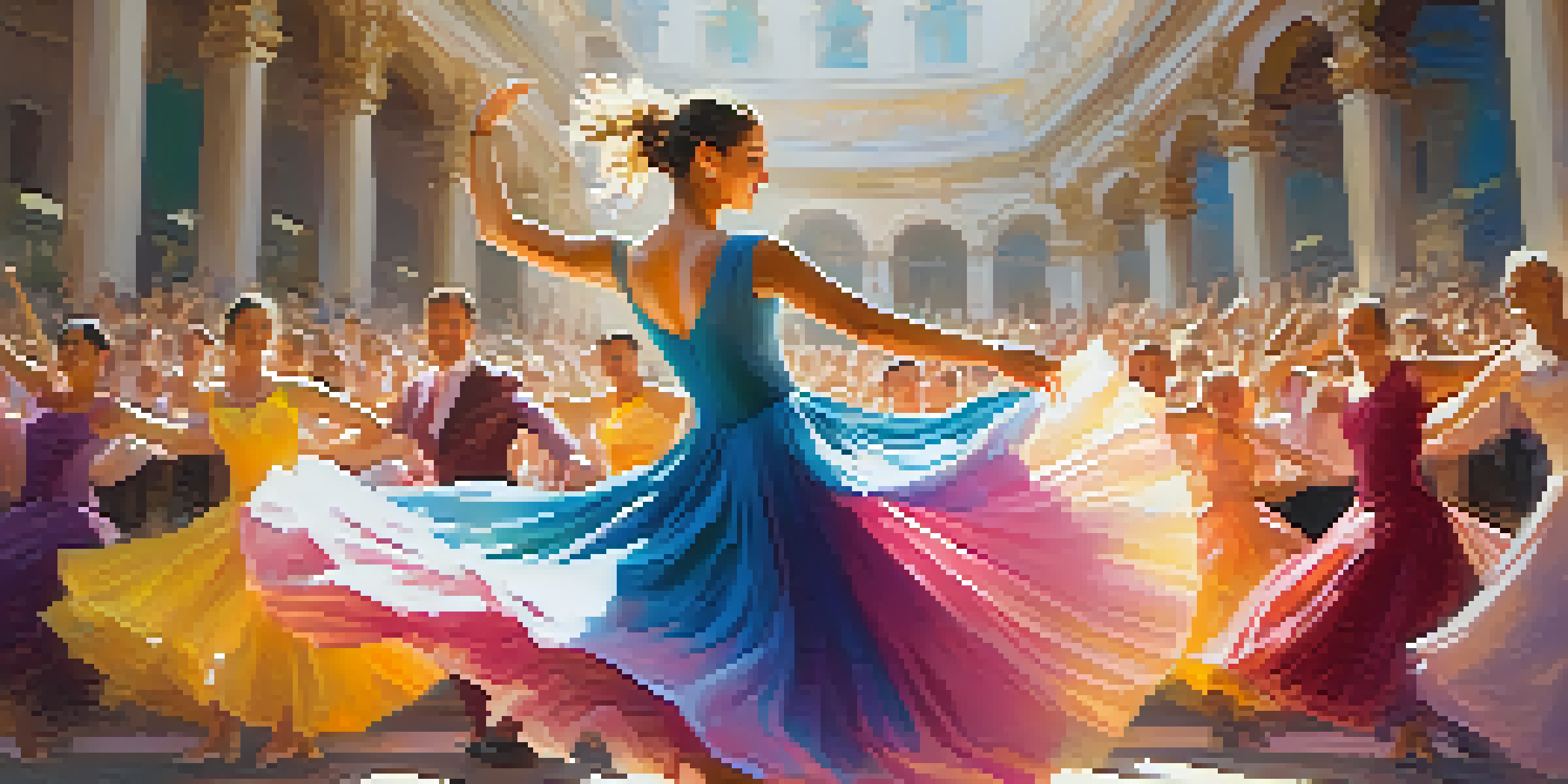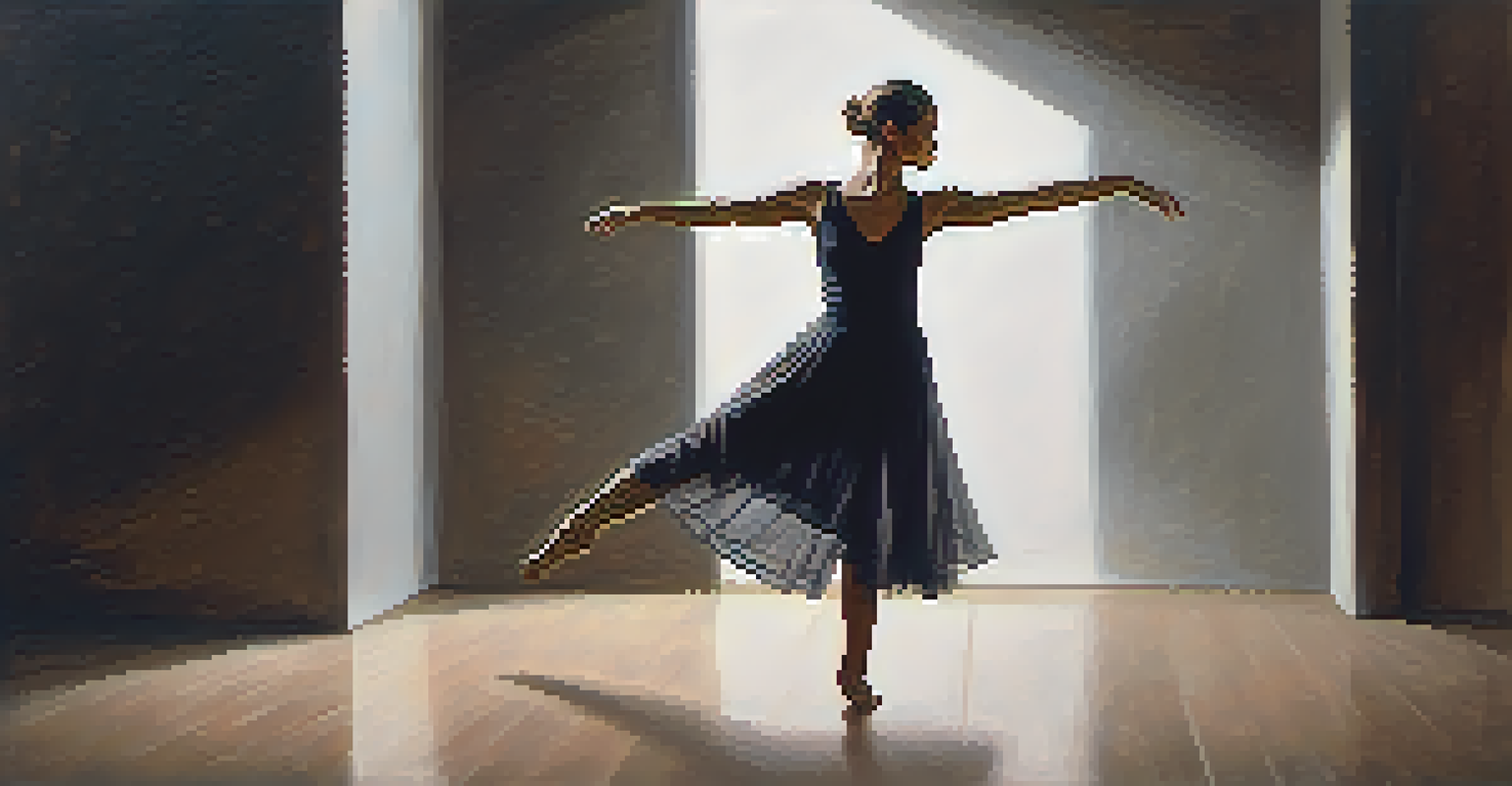Dance and Emotion: Conveying Feelings Through Movement

The Power of Dance in Expressing Emotion
Dance has long been a universal language, transcending cultural boundaries and connecting people on an emotional level. When we dance, we communicate feelings that words often fail to express. Whether it's joy, sorrow, or passion, movement can convey the depth of our experiences in ways that resonate with others.
Dance is the hidden language of the soul.
Think about how a dancer's graceful movements can evoke happiness, while a slow, heavy style might express sadness. This ability to portray complex emotions makes dance a powerful form of artistic expression. Moreover, it allows both the performer and the audience to connect deeply, sharing in the emotional journey.
As we explore the relationship between dance and emotion, it's important to recognize that each individual's interpretation can vary. A single dance piece might stir different feelings in each viewer, illustrating the unique way we all connect to movement and emotion.
Historical Context: Dance as an Emotional Outlet
Throughout history, dance has served as a significant emotional outlet. From ancient rituals to modern performances, people have used movement to express their feelings and connect with their communities. For example, traditional folk dances often narrate stories of love, loss, and celebration, providing a shared experience for participants.

In many cultures, dance has been integral to ceremonies, marking significant life events like weddings and funerals. These communal expressions of emotion not only strengthen social bonds but also help individuals process their feelings in a supportive environment. The act of dancing together can create a sense of belonging and understanding.
Dance as Emotional Expression
Dance serves as a universal language, enabling individuals to communicate feelings that words often cannot.
As we reflect on the past, we see that the emotional power of dance is nothing new; it has been woven into the fabric of human experience for centuries. This rich history sets the stage for how we understand and utilize dance as a medium for emotional expression today.
Understanding Body Language in Dance
Body language plays a crucial role in how emotions are conveyed through dance. The way a dancer holds their posture, the angles of their limbs, and the intensity of their movements can all communicate specific feelings. For instance, an open and relaxed stance often signals joy and confidence, while a hunched or closed posture may suggest sadness or insecurity.
The dance is a poem of which each movement is a word.
Moreover, the subtleties of facial expressions can enhance the emotional narrative of a dance piece. A dancer's smile can radiate happiness, while a furrowed brow might depict struggle or pain. These non-verbal cues are essential for storytelling in dance and allow the audience to connect with the performer on a deeper level.
By honing their awareness of body language, dancers can more effectively convey the emotions embedded in their movements. This skill not only enriches their performances but also invites the audience to experience the dance in a profoundly personal way.
The Role of Music in Enhancing Emotional Expression
Music and dance go hand in hand, with each element amplifying the emotional impact of the other. A powerful score can evoke specific feelings, guiding dancers in their movements and helping them embody the intended emotions. For example, an upbeat tempo can instill a sense of joy and energy, while slow, melodic tunes may evoke feelings of nostalgia or sadness.
When dancers synchronize their movements with the rhythm and dynamics of the music, they create a seamless emotional experience. This synergy not only captivates the audience but also allows the dancers to delve deeper into their emotional expression. The interplay between music and movement can transform a performance into a truly immersive experience.
Cultural Significance of Dance
Different cultures interpret and express emotions through unique dance styles, enriching the global landscape of this art form.
Additionally, different musical genres can elicit varied emotional responses, influencing how dancers interpret their choreography. This relationship highlights the importance of selecting the right music to enhance the overall emotional narrative of a dance piece.
The Therapeutic Benefits of Dance and Emotion
Dance isn’t just a performance art; it can also be a powerful therapeutic tool. Engaging in dance allows individuals to express their emotions in a safe and supportive environment. It can be particularly beneficial for those who struggle to articulate their feelings verbally, as movement provides an alternative outlet for expression.
Many therapeutic practices incorporate dance, such as dance/movement therapy, which encourages individuals to explore their emotions through movement. This approach can help reduce anxiety, improve mood, and foster a sense of empowerment. By allowing participants to connect their feelings with physical movement, dance becomes a vehicle for healing.
As more people recognize the therapeutic benefits of dance, it’s becoming a popular way to promote emotional well-being. Whether through structured therapy or informal dance sessions, the act of moving can lead to profound personal insights and emotional release.
Cultural Variations in Dance and Emotion
Dance styles vary greatly across cultures, each carrying its unique emotional expressions and meanings. For instance, traditional African dance often celebrates community and resilience, while ballet may convey themes of love and tragedy. These cultural variations enrich the global landscape of dance, showcasing how different societies interpret and express emotions through movement.
Understanding the cultural context of dance can deepen our appreciation for its emotional nuances. For example, the flamenco dance from Spain is characterized by passionate expressions of love and heartache, conveyed through intricate footwork and hand gestures. Each culture brings its own history and emotional palette to the art of dance.
Therapeutic Benefits of Dance
Engaging in dance provides a powerful therapeutic outlet, helping individuals express emotions and promote emotional well-being.
By exploring these diverse dance forms, we can gain insight into the universal yet unique ways humans experience and express emotion. This cultural richness reminds us that while feelings may be universal, the ways we convey them can be beautifully distinct.
Personal Reflection: Finding Your Emotional Voice Through Dance
Finding your emotional voice through dance can be a transformative journey. Whether you're a seasoned dancer or just starting out, exploring movement can help you connect with your feelings in a profound way. Dance allows for self-expression and can be a source of joy, healing, and empowerment.
Taking the time to discover what movements resonate with you personally can lead to deeper emotional insights. Experimenting with different styles, improvising, or even just dancing in your living room can unveil feelings you might not have been aware of. This personal exploration can foster a greater understanding of your emotions and how to express them.

Ultimately, dance offers a unique opportunity to celebrate your individuality while connecting with others. By embracing movement as a form of self-expression, you open the door to a richer emotional life and a deeper connection to those around you.